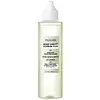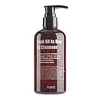What's inside
What's inside
 Key Ingredients
Key Ingredients

 Benefits
Benefits

 Concerns
Concerns

 Ingredients Side-by-side
Ingredients Side-by-side

Water
Skin ConditioningGlycerin
HumectantPotassium Cocoyl Glycinate
Lauryl Betaine
CleansingDisodium Cocoamphodiacetate
CleansingPotassium Cocoate
EmulsifyingSodium Chloride
MaskingPotassium Benzoate
Preservative4-T-Butylcyclohexanol
MaskingAvena Sativa Meal Extract
SoothingHouttuynia Cordata Extract
Skin ConditioningMelia Azadirachta Leaf Extract
Skin ConditioningMelia Azadirachta Flower Extract
Skin ConditioningCamellia Sinensis Leaf Extract
AntimicrobialHexylene Glycol
EmulsifyingPentylene Glycol
Skin Conditioning1,2-Hexanediol
Skin ConditioningButylene Glycol
HumectantDisodium EDTA
Citric Acid
BufferingWater, Glycerin, Potassium Cocoyl Glycinate, Lauryl Betaine, Disodium Cocoamphodiacetate, Potassium Cocoate, Sodium Chloride, Potassium Benzoate, 4-T-Butylcyclohexanol, Avena Sativa Meal Extract, Houttuynia Cordata Extract, Melia Azadirachta Leaf Extract, Melia Azadirachta Flower Extract, Camellia Sinensis Leaf Extract, Hexylene Glycol, Pentylene Glycol, 1,2-Hexanediol, Butylene Glycol, Disodium EDTA, Citric Acid
Water
Skin ConditioningLauramide DEA
Sodium Laureth Sulfate
CleansingTea-Lauryl Sulfate
CleansingSnail Secretion Filtrate
Skin ConditioningSodium Lauryl Sulfate
CleansingPEG-7 Glyceryl Cocoate
EmulsifyingCocamidopropyl Betaine
CleansingPotassium Cocoyl Glycinate
Sodium Cocoyl Isethionate
CleansingDipropylene Glycol
HumectantChlorphenesin
AntimicrobialCitric Acid
BufferingBetaine
HumectantPanthenol
Skin ConditioningTocopheryl Acetate
AntioxidantCamellia Sinensis Leaf Extract
AntimicrobialGinkgo Biloba Leaf Extract
Skin ConditioningCentella Asiatica Extract
CleansingDisodium EDTA
Lavandula Angustifolia Flower Extract
CleansingViola Tricolor Extract
EmollientCentaurea Cyanus Flower Extract
AstringentButylene Glycol
HumectantPentylene Glycol
Skin ConditioningMethylisothiazolinone
Preservative1,2-Hexanediol
Skin ConditioningCaprylyl Glycol
EmollientParfum
MaskingWater, Lauramide DEA, Sodium Laureth Sulfate, Tea-Lauryl Sulfate, Snail Secretion Filtrate, Sodium Lauryl Sulfate, PEG-7 Glyceryl Cocoate, Cocamidopropyl Betaine, Potassium Cocoyl Glycinate, Sodium Cocoyl Isethionate, Dipropylene Glycol, Chlorphenesin, Citric Acid, Betaine, Panthenol, Tocopheryl Acetate, Camellia Sinensis Leaf Extract, Ginkgo Biloba Leaf Extract, Centella Asiatica Extract, Disodium EDTA, Lavandula Angustifolia Flower Extract, Viola Tricolor Extract, Centaurea Cyanus Flower Extract, Butylene Glycol, Pentylene Glycol, Methylisothiazolinone, 1,2-Hexanediol, Caprylyl Glycol, Parfum
Ingredients Explained
These ingredients are found in both products.
Ingredients higher up in an ingredient list are typically present in a larger amount.
1,2-Hexanediol is a synthetic liquid and another multi-functional powerhouse.
It is a:
- Humectant, drawing moisture into the skin
- Emollient, helping to soften skin
- Solvent, dispersing and stabilizing formulas
- Preservative booster, enhancing the antimicrobial activity of other preservatives
Butylene Glycol (or BG) is used within cosmetic products for a few different reasons:
Overall, Butylene Glycol is a safe and well-rounded ingredient that works well with other ingredients.
Though this ingredient works well with most skin types, some people with sensitive skin may experience a reaction such as allergic rashes, closed comedones, or itchiness.
Learn more about Butylene GlycolCamellia Sinensis Leaf Extract is derived from the leaves of the tea plant. Black tea, green tea, and oolong tea are all harvested from this plant.
This ingredient has many skin benefits:
This ingredient contains polyphenols, a strong antioxidant. Antioxidants help fight off molecules that damage skin cells.
On top of that, the antioxidants in green tea neutralize free-radicals from the sun. This gives the skin some extra UV protection, but should not replace sunscreen.
Many components of tea have anti-inflammatory properties.
Polyphenols and L-theanine help soothe the skin and reduce irritation. The caffeine in Camellia Sinensis Leaf Extract helps calm inflamed blood vessels.
Other compounds found in tea include: Vitamin Bs, linoleic acid, magnesium, calcium, iron, and zinc.
Research has shown both drinking Camellia Sinensis Leaf Tea and applying it to the skin can help boost skin elasticity and hydration. Studies also show using tea extract may reduce sebum, or oil, production.
Learn more about Camellia Sinensis Leaf ExtractCitric Acid is an alpha hydroxy acid (AHA) naturally found in citrus fruits like oranges, lemons, and limes.
Like other AHAs, citric acid can exfoliate skin by breaking down the bonds that hold dead skin cells together. This helps reveal smoother and brighter skin underneath.
However, this exfoliating effect only happens at high concentrations (20%) which can be hard to find in cosmetic products.
Due to this, citric acid is usually included in small amounts as a pH adjuster. This helps keep products slightly more acidic and compatible with skin's natural pH.
In skincare formulas, citric acid can:
While it can provide some skin benefits, research shows lactic acid and glycolic acid are generally more effective and less irritating exfoliants.
Most citric acid used in skincare today is made by fermenting sugars (usually from molasses). This synthetic version is identical to the natural citrus form but easier to stabilize and use in formulations.
Read more about some other popular AHA's here:
Learn more about Citric AcidDisodium EDTA plays a role in making products more stable by aiding other preservatives.
It is a chelating agent, meaning it neutralizes metal ions that may be found in a product.
Disodium EDTA is a salt of edetic acid and is found to be safe in cosmetic ingredients.
Learn more about Disodium EDTAPentylene glycol is typically used within a product to thicken it. It also adds a smooth, soft, and moisturizing feel to the product. It is naturally found in plants such as sugar beets.
The hydrophilic trait of Pentylene Glycol makes it a humectant. As a humectant, Pentylene Glycol helps draw moisture from the air to your skin. This can help keep your skin hydrated.
This property also makes Pentylene Glycol a great texture enhancer. It can also help thicken or stabilize a product.
Pentylene Glycol also acts as a mild preservative and helps to keep a product microbe-free.
Some people may experience mild eye and skin irritation from Pentylene Glycol. We always recommend speaking with a professional about using this ingredient in your routine.
Pentylene Glycol has a low molecular weight and is part of the 1,2-glycol family.
Learn more about Pentylene GlycolPotassium Cocoyl Glycinate is an amino acid-based surfactant and cleaning agent. This ingredient can be derived from animals or plants. It may also be synthetically created from fatty acids of the coconut and glycine.
Potassium Cocoyl Glycinate is a gentle surfactant. Surfactants help gather the dirt, oil, and other pollutants from your skin to be rinsed away. It is a mild cleanser and naturally produces foam.
Water. It's the most common cosmetic ingredient of all. You'll usually see it at the top of ingredient lists, meaning that it makes up the largest part of the product.
So why is it so popular? Water most often acts as a solvent - this means that it helps dissolve other ingredients into the formulation.
You'll also recognize water as that liquid we all need to stay alive. If you see this, drink a glass of water. Stay hydrated!
Learn more about Water